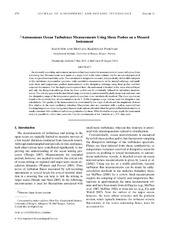Autonomous Ocean Turbulence Measurements Using Shear Probes on a Moored Instrument
Peer reviewed, Journal article
Published version
Permanent lenke
https://hdl.handle.net/1956/8678Utgivelsesdato
2014-02Metadata
Vis full innførselSamlinger
- Geophysical Institute [1198]
Originalversjon
https://doi.org/10.1175/jtech-d-13-00096.1Sammendrag
An internally recording, autonomous instrument has been tested for measurements of ocean turbulence from a mooring line. Measurements were made at a single level in the water column, but for an extended period of time, at a predetermined duty cycle.The instrument is designed to measure, independently, in two different parts of the turbulence wavenumber spectrum: eddy correlation measurements in the inertial subrange and smallscale shear and temperature gradient measurements in the dissipation subrange using shear probes and fastresponse thermistors. For the deployment reported here, the instrument is located in the wave-affected layer, and only the dissipation subrange from the shear probes can be confidently utilized for turbulence measurements. The velocity spectra in the inertial subrange are severely contaminated by platform motion and noise, and the dissipation range of the temperature gradient spectrum is not satisfactorily resolved. The shear spectra are found to be relatively free of contamination in the 1–20-Hz frequency range and are used for dissipation rate calculations. The quality of the measurements is constrained by the angle of attack and the magnitude of mean flow relative to the wave oscillatory velocities. Dissipation rates are consistent with a scaling expected from breaking long waves, when background shear isweak, and are elevated when the gradient Richardson number is small, consistent with additional turbulence production by shear. While limited to a single depth, the instrument makes it possible to collect time series for 3 weeks continuously or for 3 months at a 25% duty cycle.
